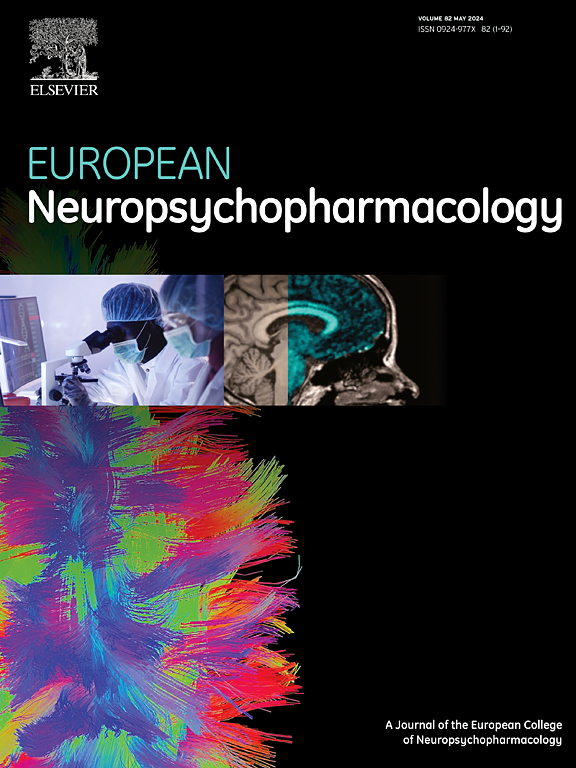195,257个个体的罕见编码变异揭示了29个新的双相情感障碍基因和蛋白质空间结构错义热点
IF 6.7
2区 医学
Q1 CLINICAL NEUROLOGY
引用次数: 0
摘要
背景双相情感障碍(BD)是一种复杂的精神障碍,其特征是复发性情绪障碍,在疾病严重程度和治疗反应上有显著差异。尽管对个体有重大影响,但导致双相障碍的遗传因素仍不完全清楚。在这里,我们介绍了双极外显子组(BipEx)联盟的最新成果。我们将不同人群的有效样本量相对于BipEx 1.0增加了5倍,以研究蛋白质截断变异体(PTVs)、拷贝数变异体(CNVs)和破坏性错译变异体在bd发病机制中的作用。方法我们的研究队列包括195,257个人,其中包括来自不同祖先人群的45,479例病例和149,778例对照。进行全外显子组测序以捕获蛋白质编码区,然后进行健壮的变体调用和严格的质量控制。我们分析了等位基因数量较少的超罕见变异<; 5,重点是ptv和破坏性错义变异。使用GATK-gCNV鉴定cnv,重点关注罕见的外显子缺失和超过三个外显子的重复。为了表征错义变异的结构收敛性,我们使用AlphaFold将变异位置映射到蛋白质3D结构上,并在整个蛋白质组的空间邻域中发现了显著的聚类。结果/讨论我们鉴定了29个fdr显著基因,包括AKAP11、SHANK1、ATP2B2、KDM5B和DOP1A,这些基因与PTVs负担增加和破坏性错义变异相关。这些基因聚集成早期和晚期神经发育表达模式,并概括了临床相关途径,包括与氯氮平反应相关的途径。利用区域错义约束指标,我们观察到在ATP2B2高度受限区域内,BD病例(而非对照组)存在破坏性错义变异。我们还在ATP2A2和G3BP2中发现了显著的3D错义聚集,这意味着结构集中的热点与BD风险有关。CNV分析显示,BPNT2是最强的缺失相关基因(OR: 9.04, P = 2.67 × 10⁻(9)),是已知的锂靶基因,BIRC6是最显著的重复命中基因(OR: 5.04, P = 2.49 × 10⁻(9))。我们还发现在15q11.2位点存在潜在的反向CNV位点的证据,该位点的重复增加了BD的风险,而缺失在某些情况下会减少。通过利用近20万个体的数据,BipEx 2.0提供了BD罕见遗传变异的全面视图,强调了PTVs、CNVs和破坏性错义变异的贡献。包括ATP2A2和G3BP2在内的错义聚合3D蛋白热点的鉴定,凸显了将结构生物学整合到精神病学基因发现中的价值。这些结果阐明了不同种类的趋同生物学机制,并为机制研究指明了新的方向。本文章由计算机程序翻译,如有差异,请以英文原文为准。
RARE CODING VARIANTS IN 195,257 INDIVIDUALS REVEAL 29 NOVEL BIPOLAR DISORDER GENES AND STRUCTURAL MISSENSE HOTSPOTS IN PROTEIN SPACE
Background
Bipolar disorder (BD) is a complex psychiatric disorder characterized by recurrent mood disturbances with significant variations in disease severity and treatment response. Despite its substantial impact on individuals, the genetic factors contributing to BD remain incompletely understood. Here, we present an updated effort from the Bipolar Exome (BipEx) consortium. We increased the effective sample size by 5-fold relative to BipEx 1.0 across diverse populations to investigate the role of protein-truncating variants (PTVs), copy number variants (CNVs), and damaging missense variants in the pathogenesis of BD.
Methods
Our study cohort comprised 195,257 individuals, including 45,479 cases and 149,778 controls from ancestrally diverse populations. Whole exome sequencing was performed to capture protein-coding regions, followed by robust variant calling and stringent quality control. We analyzed ultra-rare variants with a minor allele count < 5, focusing on PTVs and damaging missense variants. CNVs were identified using GATK-gCNV, focusing on rare exonic deletions and duplications spanning more than three exons. To characterize structural convergence of missense variation, we mapped variant positions to protein 3D structures using AlphaFold and identified significant clustering in spatial neighborhoods across the proteome.
Results/Discussion
We identified 29 FDR-significant genes, including AKAP11, SHANK1, ATP2B2, KDM5B, and DOP1A, associated with increased burden of PTVs and damaging missense variants. These genes cluster into early and late neurodevelopmental expression patterns and recapitulate clinically relevant pathways, including those associated with clozapine response. Using regional missense constraint metrics, we observed damaging missense variants in BD cases—but not controls—within a highly constrained region of ATP2B2. We also identified significant 3D missense clustering in ATP2A2 and G3BP2, implicating structurally focused hotspots as contributing to BD risk. CNV analysis revealed BPNT2 as the strongest deletion-associated gene (OR: 9.04, P = 2.67 × 10⁻⁹), a known lithium target, and BIRC6 as the most significant duplication hit (OR: 5.04, P = 2.49 × 10⁻¹⁴). We also found evidence for a potential reciprocal CNV locus at 15q11.2, where the duplication increases BD risk while the deletion is depleted in cases.
Conclusion
By leveraging data from nearly 200,000 individuals, BipEx 2.0 provides a comprehensive view of rare genetic variation in BD, emphasizing contributions from PTVs, CNVs, and damaging missense variants. The identification of missense-convergent 3D protein hotspots, including in ATP2A2 and G3BP2, highlights the value of integrating structural biology into psychiatric gene discovery. These results illuminate convergent biological mechanisms across variant classes and point to new directions for mechanistic investigation.
求助全文
通过发布文献求助,成功后即可免费获取论文全文。
去求助
来源期刊

European Neuropsychopharmacology
医学-精神病学
CiteScore
10.30
自引率
5.40%
发文量
730
审稿时长
41 days
期刊介绍:
European Neuropsychopharmacology is the official publication of the European College of Neuropsychopharmacology (ECNP). In accordance with the mission of the College, the journal focuses on clinical and basic science contributions that advance our understanding of brain function and human behaviour and enable translation into improved treatments and enhanced public health impact in psychiatry. Recent years have been characterized by exciting advances in basic knowledge and available experimental techniques in neuroscience and genomics. However, clinical translation of these findings has not been as rapid. The journal aims to narrow this gap by promoting findings that are expected to have a major impact on both our understanding of the biological bases of mental disorders and the development and improvement of treatments, ideally paving the way for prevention and recovery.
 求助内容:
求助内容: 应助结果提醒方式:
应助结果提醒方式:


